YAMAHA YZ85 2013 Service Manual
Manufacturer: YAMAHA, Model Year: 2013, Model line: YZ85, Model: YAMAHA YZ85 2013Pages: 88, PDF Size: 1.74 MB
Page 41 of 88

FOR YOUR SAFETY – PRE-OPERATION CHECKS
5-3
5
Front fork and rear shock ab-
sorber assembly Check that they operate smoothly and there
is no oil leakage. 4-7, 4-9, 4-9, 7-26
Chassis fasteners Make sure that all nuts, bolts and screws are properly tightened.
Tighten if necessary.
—
Moving parts and cables Check that the control cables move smoothly.
Check that the control cables are not caught when the handlebars are turned or
when the front forks travel up and down.
Lubricate moving parts and cables if necessary. 7-24, 7-24, 7-26, 7-25
Exhaust system Check that the exhaust pipe is tightly mounted and has no cracks.
Check for leakage. —
Ignition system Check that all leads and cables are properly connected. 7-8
ITEM CHECKS PAGE
U1SN81E0.book Page 3 Tuesday, June 12, 2012 3:17 PM
Page 42 of 88
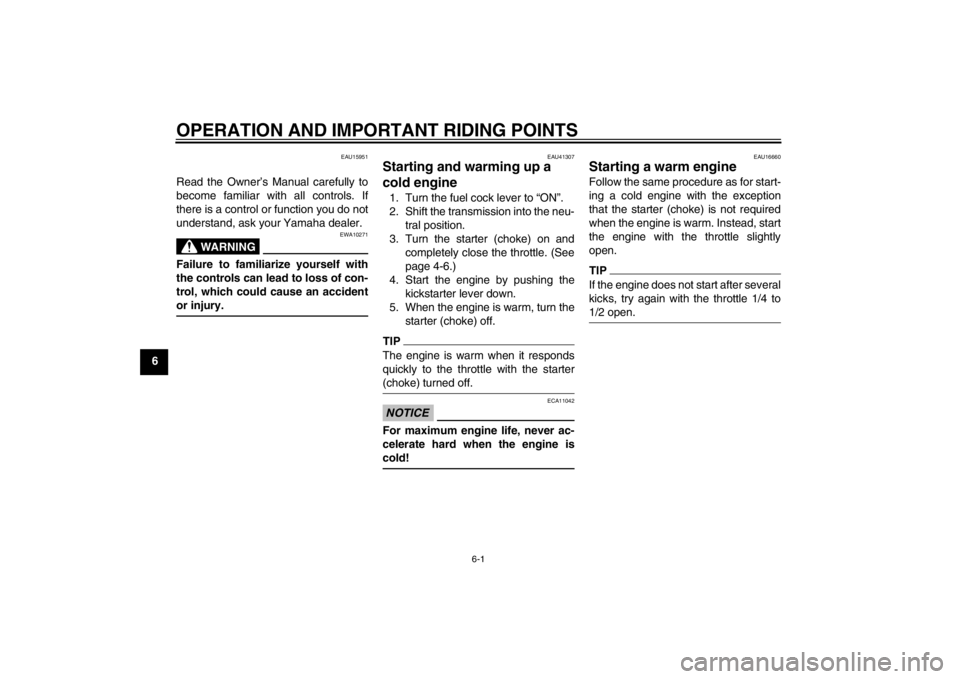
OPERATION AND IMPORTANT RIDING POINTS
6-1
6
EAU15951
Read the Owner’s Manual carefully to
become familiar with all controls. If
there is a control or function you do not
understand, ask your Yamaha dealer.
WARNING
EWA10271
Failure to familiarize yourself with
the controls can lead to loss of con-
trol, which could cause an accident
or injury.
EAU41307
Starting and warming up a
cold engine 1. Turn the fuel cock lever to “ON”.
2. Shift the transmission into the neu-tral position.
3. Turn the starter (choke) on and completely close the throttle. (See
page 4-6.)
4. Start the engine by pushing the kickstarter lever down.
5. When the engine is warm, turn the starter (choke) off.TIPThe engine is warm when it responds
quickly to the throttle with the starter
(choke) turned off.NOTICE
ECA11042
For maximum engine life, never ac-
celerate hard when the engine is
cold!
EAU16660
Starting a warm engine Follow the same procedure as for start-
ing a cold engine with the exception
that the starter (choke) is not required
when the engine is warm. Instead, start
the engine with the throttle slightly
open.TIPIf the engine does not start after several
kicks, try again with the throttle 1/4 to
1/2 open.
U1SN81E0.book Page 1 Tuesday, June 12, 2012 3:17 PM
Page 43 of 88
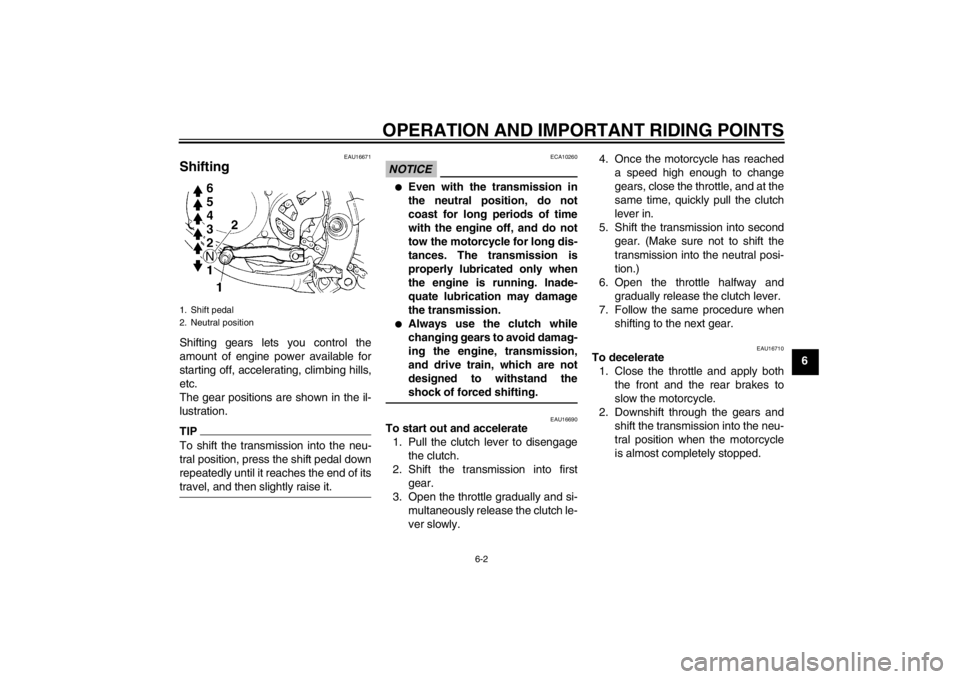
OPERATION AND IMPORTANT RIDING POINTS
6-2
6
EAU16671
Shifting Shifting gears lets you control the
amount of engine power available for
starting off, accelerating, climbing hills,
etc.
The gear positions are shown in the il-
lustration.TIPTo shift the transmission into the neu-
tral position, press the shift pedal down
repeatedly until it reaches the end of its
travel, and then slightly raise it.
NOTICE
ECA10260
●
Even with the transmission in
the neutral position, do not
coast for long periods of time
with the engine off, and do not
tow the motorcycle for long dis-
tances. The transmission is
properly lubricated only when
the engine is running. Inade-
quate lubrication may damage
the transmission.
●
Always use the clutch while
changing gears to avoid damag-
ing the engine, transmission,
and drive train, which are not
designed to withstand the
shock of forced shifting.
EAU16690
To start out and accelerate1. Pull the clutch lever to disengage the clutch.
2. Shift the transmission into first gear.
3. Open the throttle gradually and si- multaneously release the clutch le-
ver slowly. 4. Once the motorcycle has reached
a speed high enough to change
gears, close the throttle, and at the
same time, quickly pull the clutch
lever in.
5. Shift the transmission into second gear. (Make sure not to shift the
transmission into the neutral posi-
tion.)
6. Open the throttle halfway and gradually release the clutch lever.
7. Follow the same procedure when shifting to the next gear.
EAU16710
To decelerate1. Close the throttle and apply both the front and the rear brakes to
slow the motorcycle.
2. Downshift through the gears and shift the transmission into the neu-
tral position when the motorcycle
is almost completely stopped.
1. Shift pedal
2. Neutral position
U1SN81E0.book Page 2 Tuesday, June 12, 2012 3:17 PM
Page 44 of 88
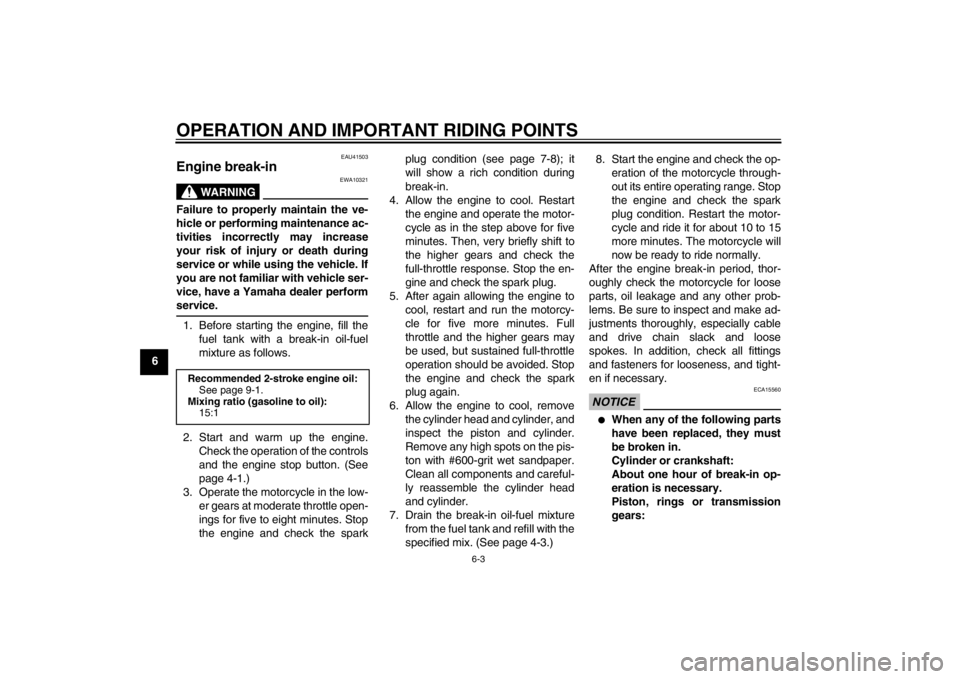
OPERATION AND IMPORTANT RIDING POINTS
6-3
6
EAU41503
Engine break-in
WARNING
EWA10321
Failure to properly maintain the ve-
hicle or performing maintenance ac-
tivities incorrectly may increase
your risk of injury or death during
service or while using the vehicle. If
you are not familiar with vehicle ser-
vice, have a Yamaha dealer perform
service.1. Before starting the engine, fill thefuel tank with a break-in oil-fuel
mixture as follows.
2. Start and warm up the engine. Check the operation of the controls
and the engine stop button. (See
page 4-1.)
3. Operate the motorcycle in the low- er gears at moderate throttle open-
ings for five to eight minutes. Stop
the engine and check the spark plug condition (see page 7-8); it
will show a rich condition during
break-in.
4. Allow the engine to cool. Restart the engine and operate the motor-
cycle as in the step above for five
minutes. Then, very briefly shift to
the higher gears and check the
full-throttle response. Stop the en-
gine and check the spark plug.
5. After again allowing the engine to cool, restart and run the motorcy-
cle for five more minutes. Full
throttle and the higher gears may
be used, but sustained full-throttle
operation should be avoided. Stop
the engine and check the spark
plug again.
6. Allow the engine to cool, remove the cylinder head and cylinder, and
inspect the piston and cylinder.
Remove any high spots on the pis-
ton with #600-grit wet sandpaper.
Clean all components and careful-
ly reassemble the cylinder head
and cylinder.
7. Drain the break-in oil-fuel mixture from the fuel tank and refill with the
specified mix. (See page 4-3.) 8. Start the engine and check the op-
eration of the motorcycle through-
out its entire operating range. Stop
the engine and check the spark
plug condition. Restart the motor-
cycle and ride it for about 10 to 15
more minutes. The motorcycle will
now be ready to ride normally.
After the engine break-in period, thor-
oughly check the motorcycle for loose
parts, oil leakage and any other prob-
lems. Be sure to inspect and make ad-
justments thoroughly, especially cable
and drive chain slack and loose
spokes. In addition, check all fittings
and fasteners for looseness, and tight-
en if necessary.
NOTICE
ECA15560
●
When any of the following parts
have been replaced, they must
be broken in.
Cylinder or crankshaft:
About one hour of break-in op-
eration is necessary.
Piston, rings or transmission
gears:
Recommended 2-stroke engine oil: See page 9-1.
Mixing ratio (gasoline to oil): 15:1
U1SN81E0.book Page 3 Tuesday, June 12, 2012 3:17 PM
Page 45 of 88
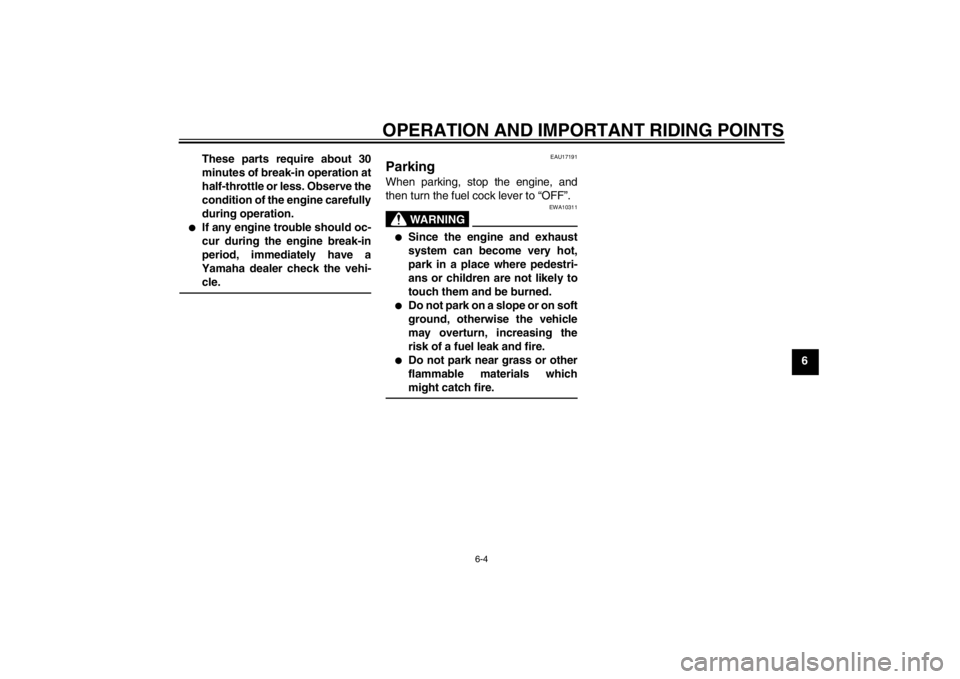
OPERATION AND IMPORTANT RIDING POINTS
6-4
6
These parts require about 30
minutes of break-in operation at
half-throttle or less. Observe the
condition of the engine carefully
during operation.
●
If any engine trouble should oc-
cur during the engine break-in
period, immediately have a
Yamaha dealer check the vehi- cle.
EAU17191
Parking When parking, stop the engine, and
then turn the fuel cock lever to “OFF”.
WARNING
EWA10311
●
Since the engine and exhaust
system can become very hot,
park in a place where pedestri-
ans or children are not likely to
touch them and be burned.
●
Do not park on a slope or on soft
ground, otherwise the vehicle
may overturn, increasing the
risk of a fuel leak and fire.
●
Do not park near grass or other
flammable materials which
might catch fire.
U1SN81E0.book Page 4 Tuesday, June 12, 2012 3:17 PM
Page 46 of 88

PERIODIC MAINTENANCE AND ADJUSTMENT
7-1
7
EAU42073
Periodic inspection, adjustment, and lu-
brication will keep your vehicle in the
safest and most efficient condition pos-
sible. Safety is an obligation of the vehi-
cle owner/operator. The most important
points of vehicle inspection, adjust-
ment, and lubrication are explained on
the following pages.
The intervals given in the periodic
maintenance and lubrication chart
should be simply considered as a gen-
eral guide under normal riding condi-
tions. However, depending on the
weather, terrain, geographical location,
and individual use, the maintenance in-
tervals may need to be shortened.
WARNING
EWA10321
Failure to properly maintain the ve-
hicle or performing maintenance ac-
tivities incorrectly may increase
your risk of injury or death during
service or while using the vehicle. If
you are not familiar with vehicle ser-
vice, have a Yamaha dealer perform
service.
WARNING
EWA15122
Turn off the engine when performing
maintenance unless otherwise
specified.●
A running engine has moving
parts that can catch on body
parts or clothing and electrical
parts that can cause shocks or
fires.
●
Running the engine while ser-
vicing can lead to eye injury,
burns, fire, or carbon monoxide
poisoning – possibly leading to
death. See page 2-2 for more in-
formation about carbon monox-
ide.WARNING
EWA15460
Brake discs, calipers, drums, and
linings can become very hot during
use. To avoid possible burns, let
brake components cool before
touching them.
U1SN81E0.book Page 1 Tuesday, June 12, 2012 3:17 PM
Page 47 of 88

PERIODIC MAINTENANCE AND ADJUSTMENT
7-2
7
EAU41799
Periodic maintenance and lubrication chart The following chart is intended as a general guide to maintenance and lubrication. Bear in mind that such factors as weather,
terrain, geographical location, and individual usage will alter the required maintenance and lubrication intervals. If you are in
doubt as to what intervals to follow in maintaining and lubricating your motorcycle, consult your Yamaha dealer.TIPItems marked with an asterisk should be performed by a Yamaha dealer as they require special tools, data and technical
skills.NO. ITEM ROUTINEAfter
break-in Every
race Every
third race Every
fifth race As
required
1 *Piston Check piston for carbon deposits and cracks or dam-
age.
Clean. √
√
√
Replace. √
√
2 *Piston rings Check piston ring end gap and rings for damage.
√
Replace.
3 *Piston pin and small
end bearing
Check piston pin and small end bearing for damage. √√√
Replace. √
√
4
*Cylinder head Check cylinder head for carbon deposits.
Clean.
√
√
√
Check cylinder head gasket for damage.
Replace cylinder head gasket. Tighten cylinder head nuts if necessary. √
U1SN81E0.book Page 2 Tuesday, June 12, 2012 3:17 PM
Page 48 of 88
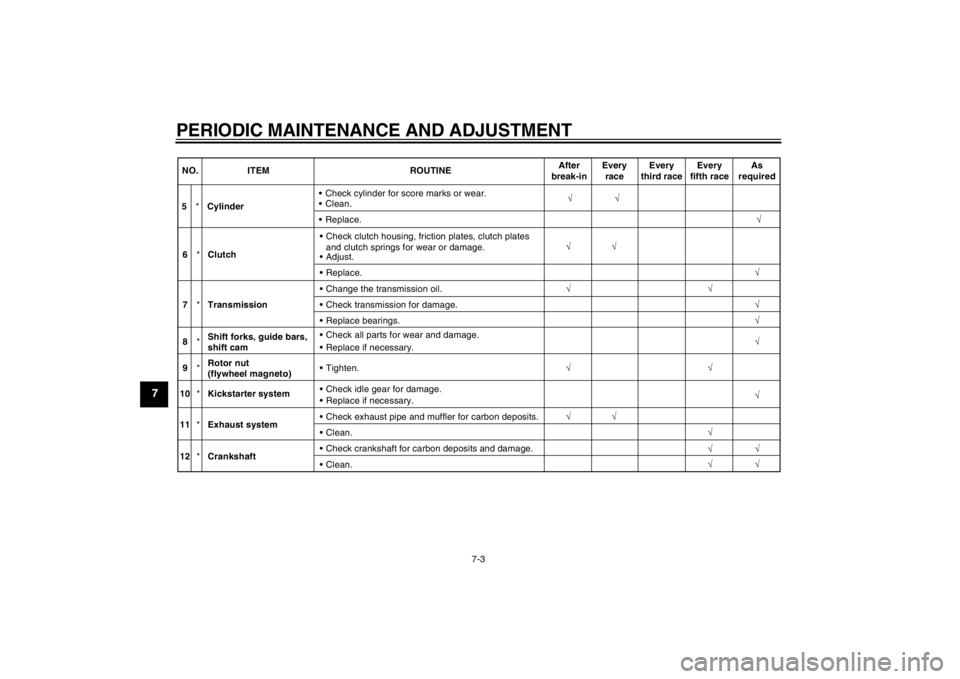
PERIODIC MAINTENANCE AND ADJUSTMENT
7-3
7
√
5 *Cylinder Check cylinder for score marks or wear.
Clean.
√
Replace. √
NO. ITEM ROUTINE
After
break-in Every
race Every
third race Every
fifth race As
required
6 *Clutch Check clutch housing, friction plates, clutch plates
and clutch springs for wear or damage.
Adjust. √
√
Replace. √
7 *Transmission Change the transmission oil.
√
Check transmission for damage. √
Replace bearings. √
8 *Shift forks, guide bars,
shift cam
Replace if necessary. Check all parts for wear and damage.
√
9 *Rotor nut
(flywheel
magneto) Tighten.
√√√
10 *Kickstarter system Check idle gear for damage.
√
Replace if necessary.
11 *Exhaust system Check exhaust pipe and muffler for carbon deposits.
√
√
Clean. √
√
√
√
√
12
*Crankshaft Check crankshaft for carbon deposits and damage.
Clean.
U1SN81E0.book Page 3 Tuesday, June 12, 2012 3:17 PM
Page 49 of 88
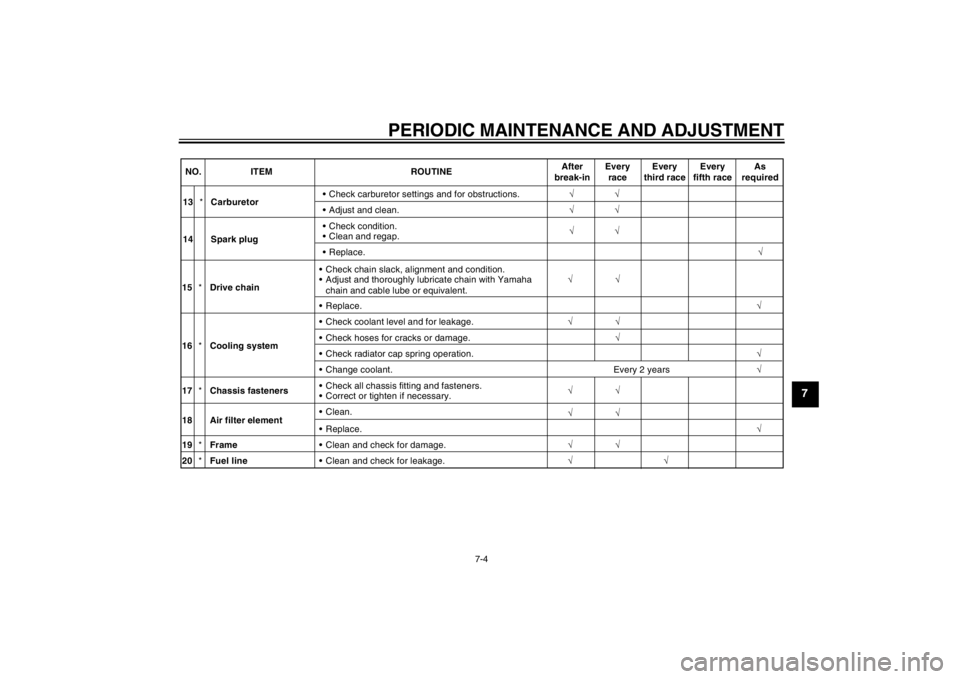
PERIODIC MAINTENANCE AND ADJUSTMENT
7-4
7
NO.ITEM ROUTINEAfter
break-in Every
race Every
third race Every
fifth race As
required
√
√
√
13
*Carburetor Check carburetor settings and for obstructions.
√
Adjust and clean. √
14 Spark plug Check condition.
Clean and regap.
√
Replace. √
15 Drive chain Check chain slack, alignment and condition.
Adjust and thoroughly lubricate chain with Yamaha
chain and cable lube or equivalent. √
√
√
√
√
Replace. √
16 * *
Cooling system Check coolant level and for leakage.
√
√
Check hoses for cracks or damage. √
Check radiator cap spring operation. √
Change coolant. Every 2 years√
17 *Chassis fasteners Check all chassis fitting and fasteners.
Correct or tighten if necessary. √
18 Air filter element Clean.
√
Replace. √
19 *Frame Clean and check for damage. √
20 *Fuel line Clean and check for leakage. √√
U1SN81E0.book Page 4 Tuesday, June 12, 2012 3:17 PM
Page 50 of 88
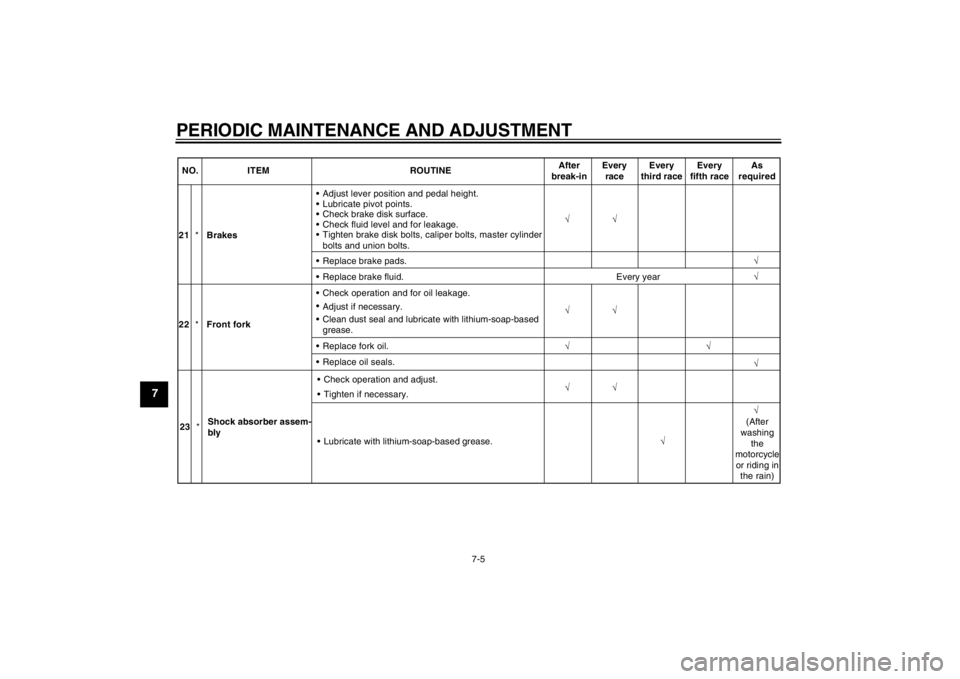
PERIODIC MAINTENANCE AND ADJUSTMENT
7-5
7
√ √
21 *Brakes Adjust lever position and pedal height.
Lubricate pivot points.
Check brake disk surface.
Check fluid level and for leakage.
Tighten brake disk bolts, caliper bolts, master cylinder
bolts and union bolts. √
Replace brake pads. √
Replace brake fluid. Every year√
22 *Front fork
Replace oil seals. Replace fork oil.
Clean dust seal and lubricate with lithium-soap-based
grease.Adjust if necessary.
Check operation and for oil leakage.
√
√√√
NO. ITEM ROUTINE
After
break-in Every
race Every
third race Every
fifth race As
required
√
√
√
23 *Shock absorber assem-
bly Check operation and adjust.
Tighten if necessary.
Lubricate with
lithium-soap-based grease
. √(After
washing the
motorcycle or riding in the rain)
U1SN81E0.book Page 5 Tuesday, June 12, 2012 3:17 PM